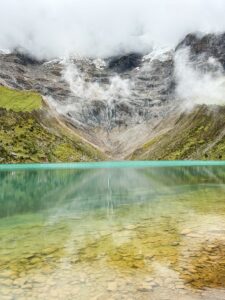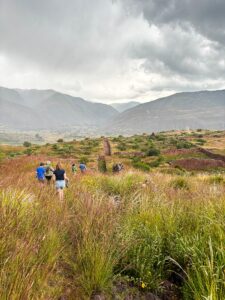Visit Machu Picchu | Ultimate Travel Guide
When you think of Peru, it’s hard not to conjure images of Machu Picchu. This iconic archaeological wonder is a testament to the ingenuity and architectural prowess of the ancient Inca civilization. But beyond its fame lies a journey waiting for you to embark upon, a journey that promises awe-inspiring vistas, rich history, delicious food, and unforgettable experiences.
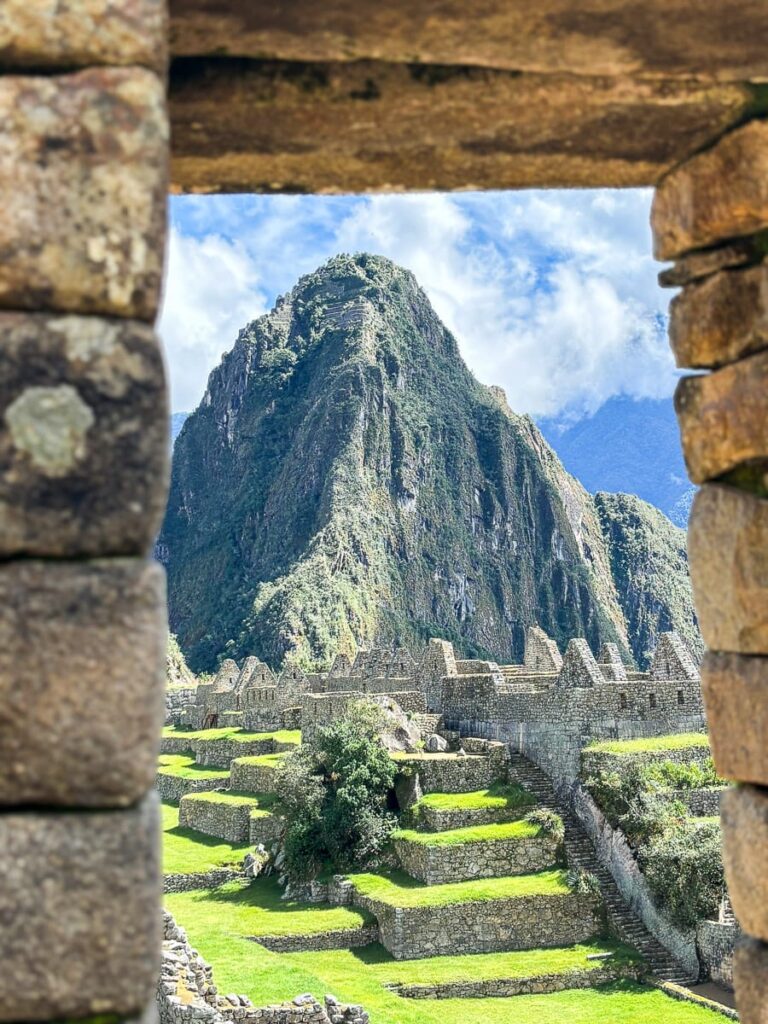
Whether you’re planning your trip or have already secured your ticket, join us in this post as we delve into our adventure, sharing insights, tips, and the magic we encountered along the way to uncovering the mysteries of Machu Picchu.
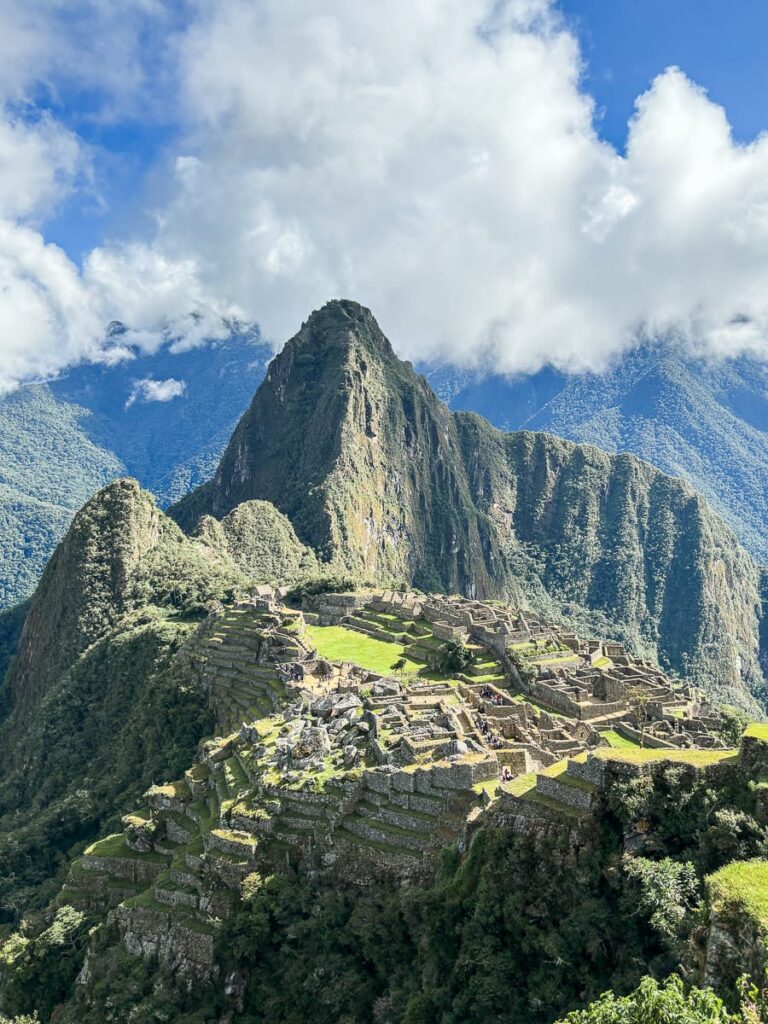
Disclosure: This post contains some affiliate links or referral links for your convenience. It is a way for this site to earn advertising commissions by advertising or linking to specific products and/or services. Click here to read our full disclosure policy.
Why visit Machu Picchu
Machu Picchu, often dubbed the “Lost City of the Incas,” is an awe-inspiring archaeological site nestled high in the Andes Mountains of Peru. Built in the 15th century during the height of the Inca Empire, it served as a sacred sanctuary, royal estate, and astronomical observatory for its inhabitants.
Perched on a ridge overlooking the Urubamba River valley, Machu Picchu is renowned for its stunning architecture, blending seamlessly with the natural landscape. Its intricate stone structures, including temples, terraces, and residential areas, showcase the exceptional engineering prowess of the ancient Inca civilization.
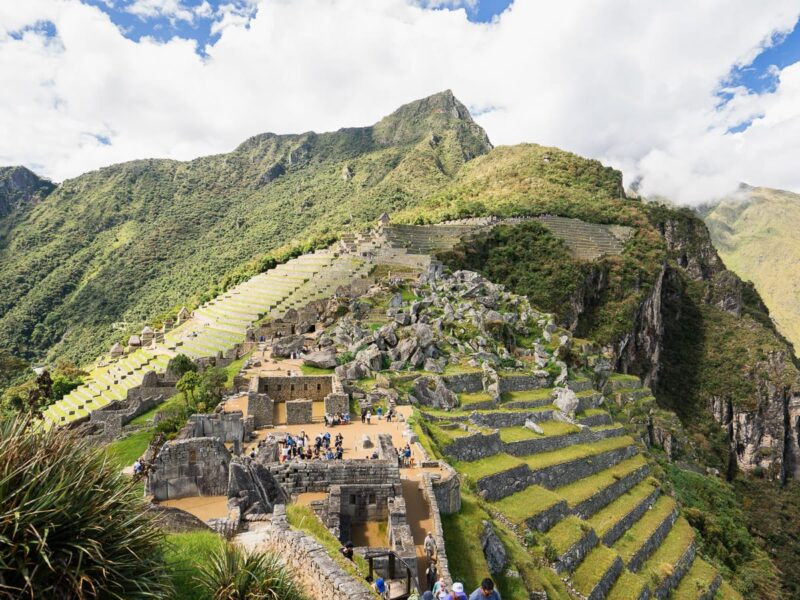
Machu Picchu was designated a UNESCO World Heritage Site in 1983, recognizing its outstanding universal value and cultural significance. This prestigious status highlights the importance of preserving Machu Picchu for future generations and acknowledging its status as a global treasure.
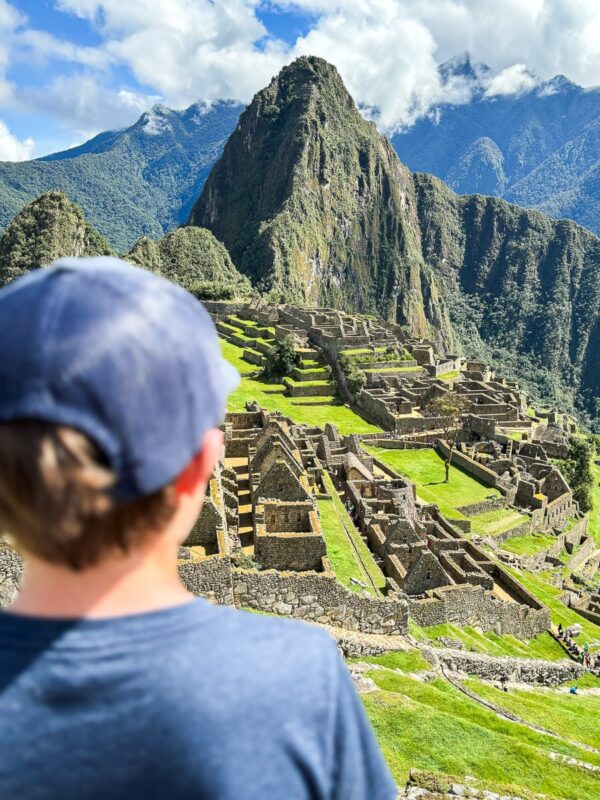
Machu Picchu typically attracts hundreds of thousands of visitors each year, making it one of the most visited archaeological sites in the world; however, to help ensure that the site is not overwhelmed by crowds and that its fragile structures and environment are preserved for years to come the Peruvian government has implemented regulations to limit the number of visitors to Machu Picchu to around 4,500 per day.
We have highlighted what we feel are some of the most essential pieces of information as you prepare for your adventure to Machu Picchu, but we have only visited once. We will only convey information based on our experiences and research. Please be sure to choose the best options for you and do your research before your trip.
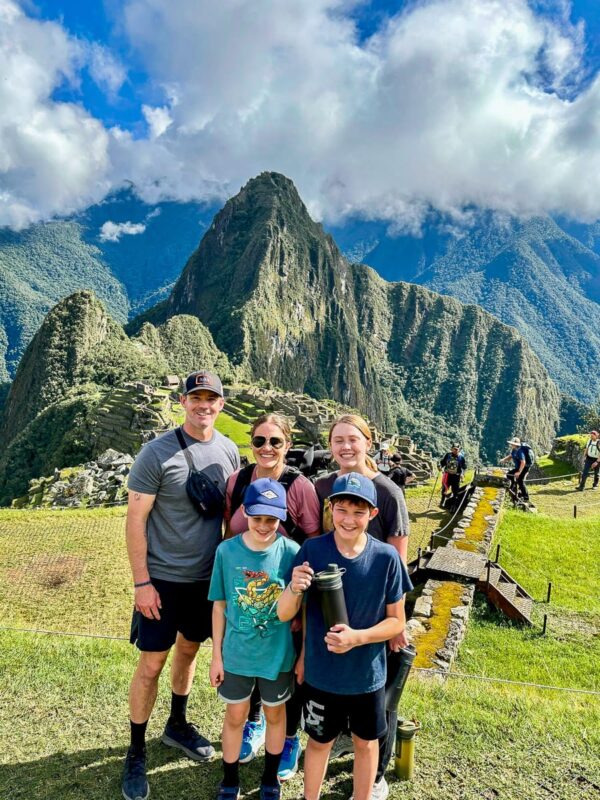
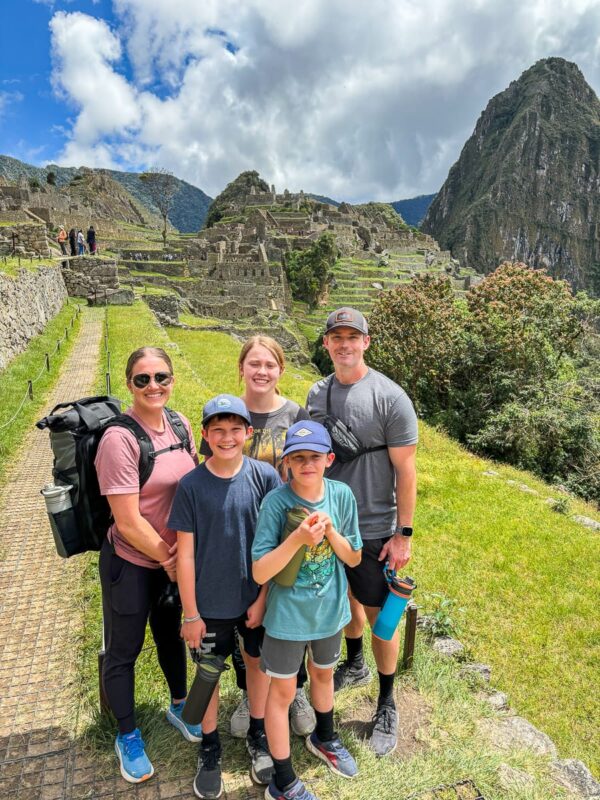
How do you get to Machu Picchu?
How to get to Machu Picchu is a big question, as there are so many options and a lot of information to unpack here!
First, if you are flying into Peru from outside the country, you will almost certainly fly into Lima (Jorge Chavez International Airport – LIM) and then catch a connecting flight to Cusco.
Driving or catching a bus from Lima is possible, but we were told it is around 20-30 hours one way. If you have the time, this would be a great way to see more of the country, but you would want to research beforehand.
We opted to fly into Lima and spend a full day exploring the city before catching a flight to Cusco the next afternoon. We found our time in Lima to be underwhelming. We don’t regret exploring the city since we have never been there before, but we would probably skip it altogether and go straight to Cusco if your time is short and your main objective is exploring Cusco, the surrounding area, and Machu Picchu.
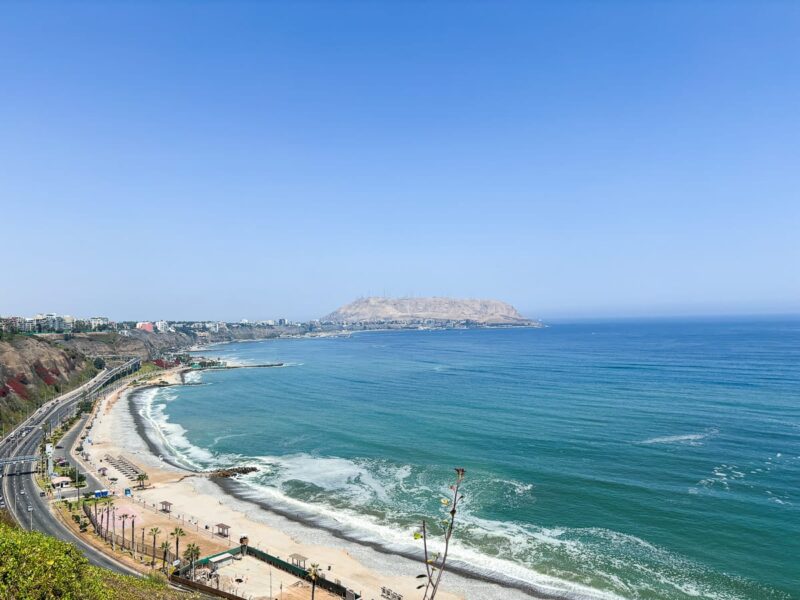
SIDENOTE: Uber is available and a great option in Peru. The Uber from the airport to Miraflores was 80 soles (including tip) and 86 soles for the return trip (including tip). The cost was for seven people, so it was affordable (roughly $20 – $23 USD).
The Lima airport is comparatively small and easy to navigate, especially for domestic flights (flights in-country). There is not much after-security for domestic travel, so if you are hungry, we’d recommend hitting the food court before security. The international terminal had more options after the security checkpoint.
Arrival in Cusco is a pretty fun descent. The airport is in the middle of the city, so you can take in the beautiful mountain landscape and red tile roof construction as you land.
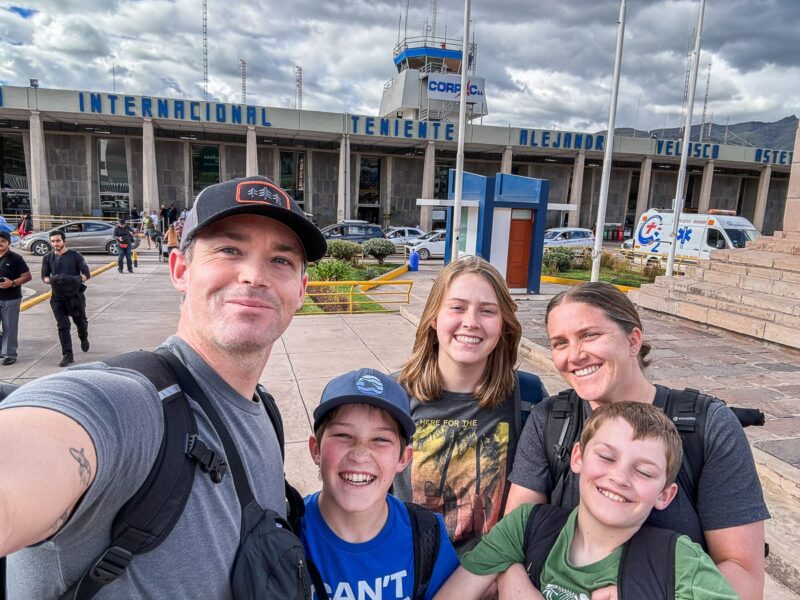
The airport in Cusco is very small. We organized a transfer from the airport to our Airbnb with our excursion company ahead of time, which made the process very easy. However, you could easily catch a taxi or hire a driver outside the doors. Uber is also available here in Cusco.
TIP: We recommend using Airalo for data on your phone, which allows you to download your eSim ahead of time, where available, for immediate connectivity upon arrival in the country.
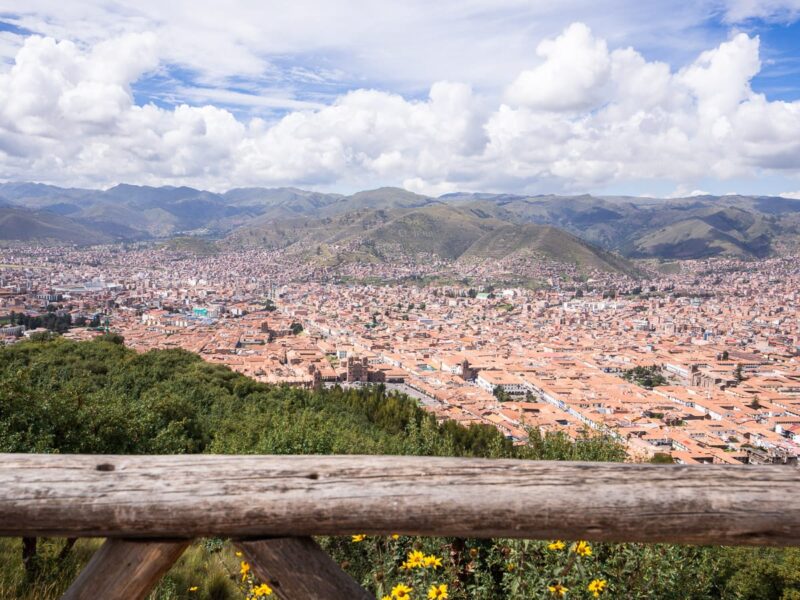
From Cusco, you have various options for getting to Machu Picchu! Regardless of your choice, it will likely entail multiple modes of transportation as there is no direct road to Machu Picchu.
- Multi-day tour through the Sacred Valley on a guided tour (private or group)
- Multi-day hiking trek on the Inca trail
- There are various route options and day lengths, but one unique advantage is the ability to enter Machu Picchu through the Sun Gate.
- Single-day tour from Cusco to Machu Picchu, returning the same day
- On your own
- It is more to book, plan, and coordinate but can be more budget-friendly.
If you choose to hike the Inca Trail, which is one of the most popular ways to reach Machu Picchu but may also be one of the most difficult, look to book your tours well in advance (6 months+) as the government limits the number of people on the trail. Along your hike, you will visit many ruins and beautiful landscapes and walk where the original Incas walked to access Machu Picchu. Depending on your preference and fitness levels, various options range from a couple of days to a week.
- Salkantay Trek
- Lares Trek (does not enter through the Sun Gate)
Trains leave from Poroy (just outside of Cusco) and travel directly to Aguas Calientes (the base town for Machu Picchu), which takes about 4 hours one-way. They can vary significantly in price depending on your preferred level of luxury.
Take a bus, taxi, or tour to Ollantaytambo (driving straight there takes about 1-2 hours) and then catch a train from Ollantaytambo to Aguas Calientes (the train takes about 2 hours one way).
Driving to Ollantaytambo offers a lot of flexibility and allows you to visit sites within the Sacred Valley on your way to Aguas Calientes. There are so many excellent sites to see on your way, including, but not limited to, Pisac, Ollantaytambo, Maras, and Moray.
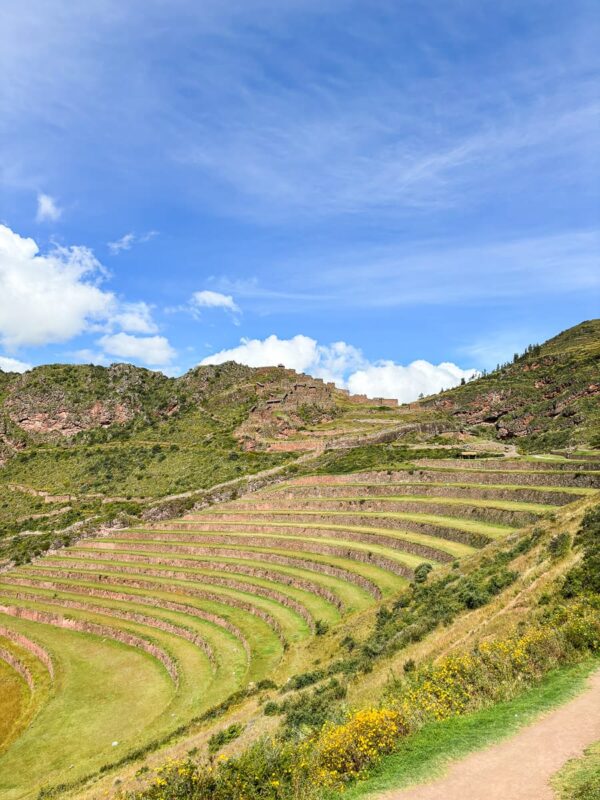
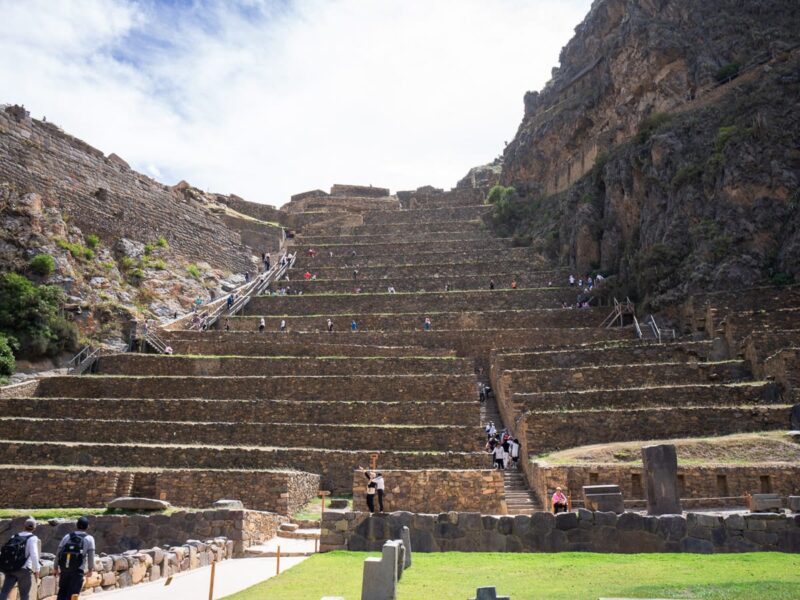
If you use Cusco as your home base, you can also do these as day trips (which is what we did). The train from Ollantaytambo to Aguas Calientes takes about 2 hours one way.
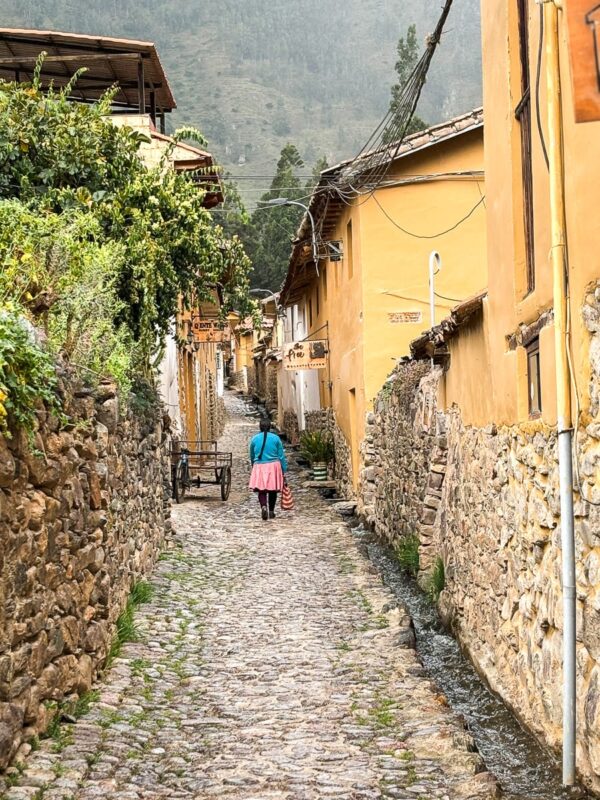
TIP: The only way to reach Aguas Calientes is by train or hiking.
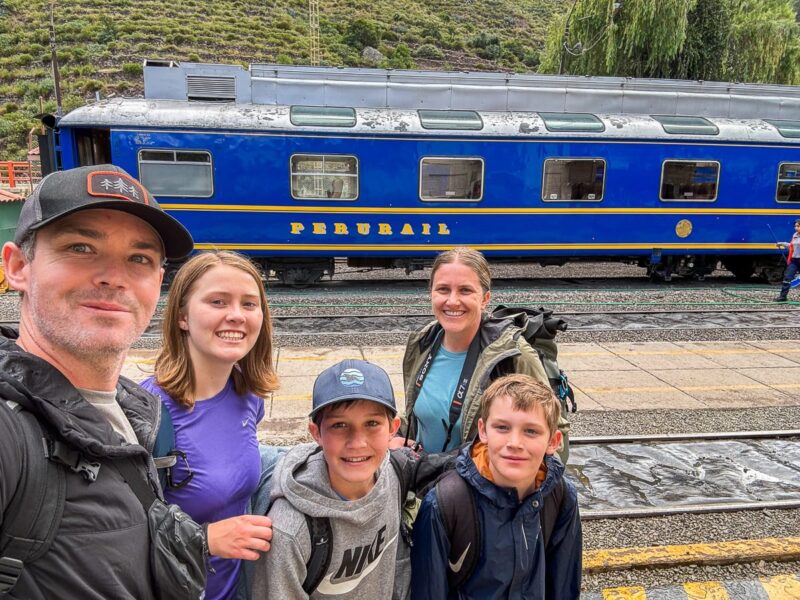
Once you arrive in Aguas Calientes, our recommendation is to arrive the night before you plan to visit Machu Picchu, take some time to wander this small town, check out the hot springs, and eat a good meal.
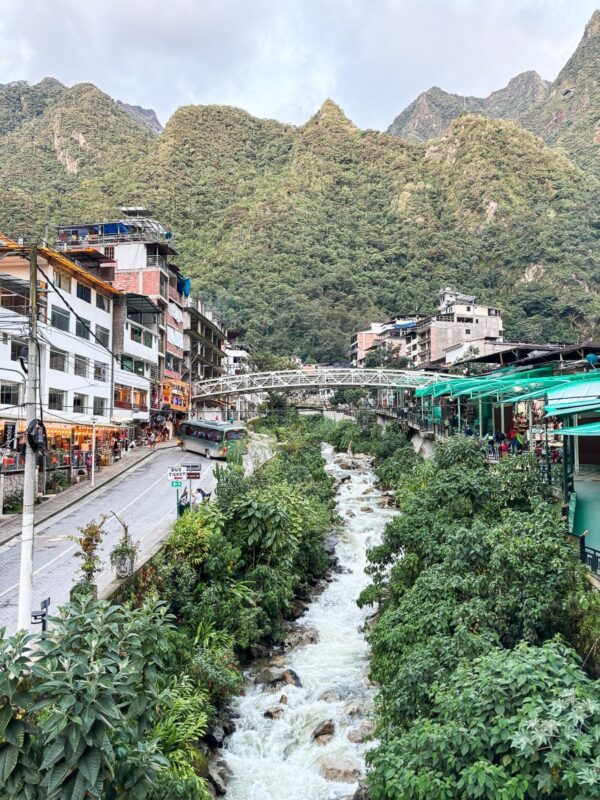
Your Machu Picchu admission ticket is good for entrance an hour from the admission time, but you will want to plan accordingly. The quickest way to get to the entrance from Aguas Calientes is by bus. You will need your tickets and passport to board. The lines started queuing early, and we arrived at our line about 40 minutes before our admission time. The lines are long but move swiftly. The bus ride is about 25 minutes long. You can hike to the top or down if you are adventurous.
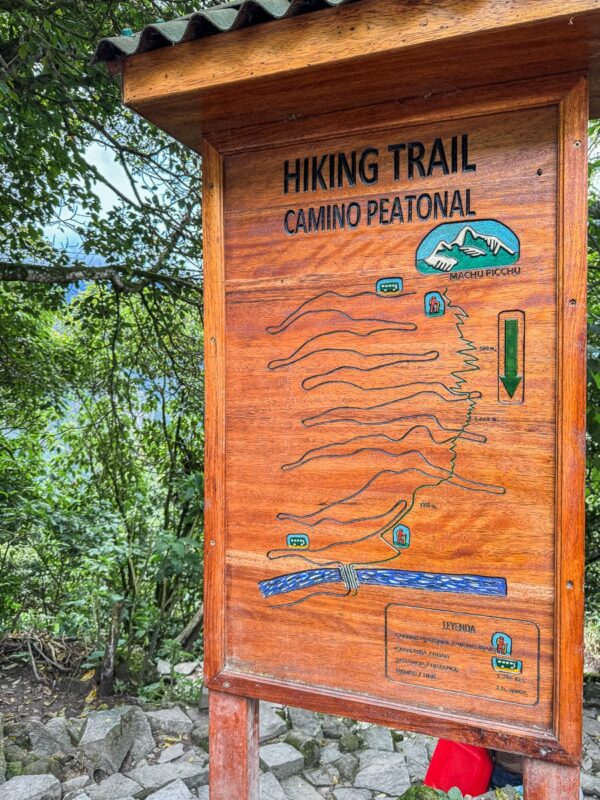
How we got to Machu Picchu
We chose to book a two-day excursion through NATIVA EXPEDITIONS (with whom we spent the whole week while in Cusco). This allowed us to explore the sacred valley (Pisac and Ollantaytambo) by private van before making our way by train from Ollantaytambo to Aguas Calientes for an overnight stay and then onto Machu Picchu the next day.
Our fantastic guide was with us for the entire two days. The itinerary included private transportation from our Airbnb in Cusco, site visits to Pisac and Ollantaytambo, lunch, overnight accommodation in Aguas Calientes, train tickets from Ollantaytambo to Aguas Calientes, and Machu Picchu admission tickets. It took the stress out of planning and booking for all seven of us and allowed us to appreciate and experience the sacred valley and Machu Picchu in a combined tour.
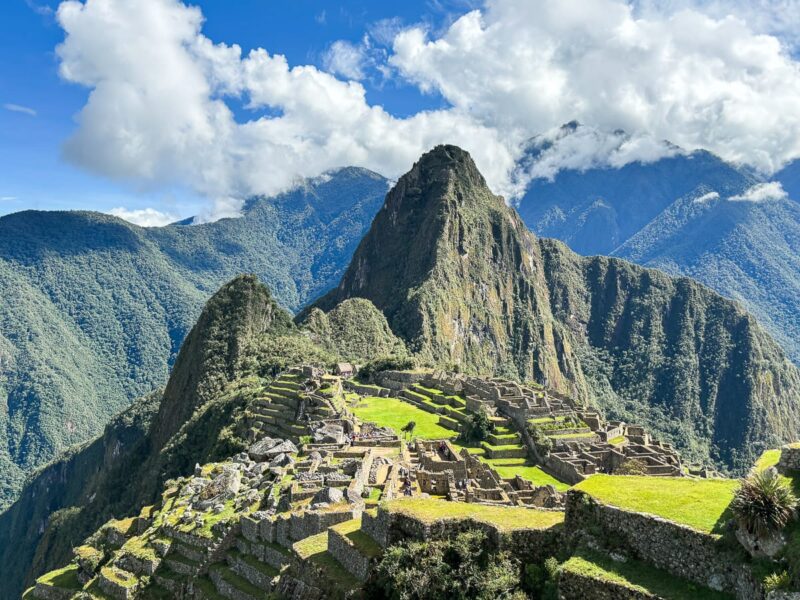
Best time to Visit?
Exploring Machu Picchu offers a magical experience regardless of when you visit, but hitting some good weather can significantly enhance your journey.
The official rainy season spans from October to April, meaning precipitation is more prevalent during these months. However, due to the region’s microclimates, rain can surprise you at any time of the year. Therefore, it’s wise to pack waterproof gear regardless of your chosen travel dates.
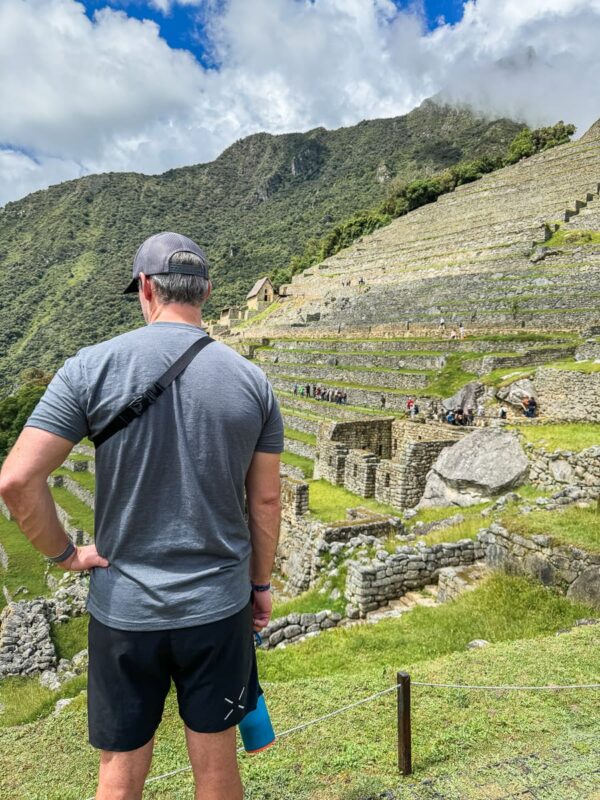
Machu Picchu typically experiences mild to warm temperatures year-round, with average highs ranging from 66°F (19°C) to 77°F (25°C) and lows between 46°F (8°C) to 54°F (12°C). These moderate temperatures offer comfortable conditions for exploration but also underscore the importance of layering clothing to adapt to potential fluctuations throughout the day.
The peak tourist season occurs during July and August when crowds swell. If you prefer a quieter atmosphere, consider scheduling your visit during shoulder seasons, such as April, May, June, September, or early October. Sundays tend to be exceptionally bustling, as residents of the Cusco province enjoy free entry alongside the daily visitor quota.
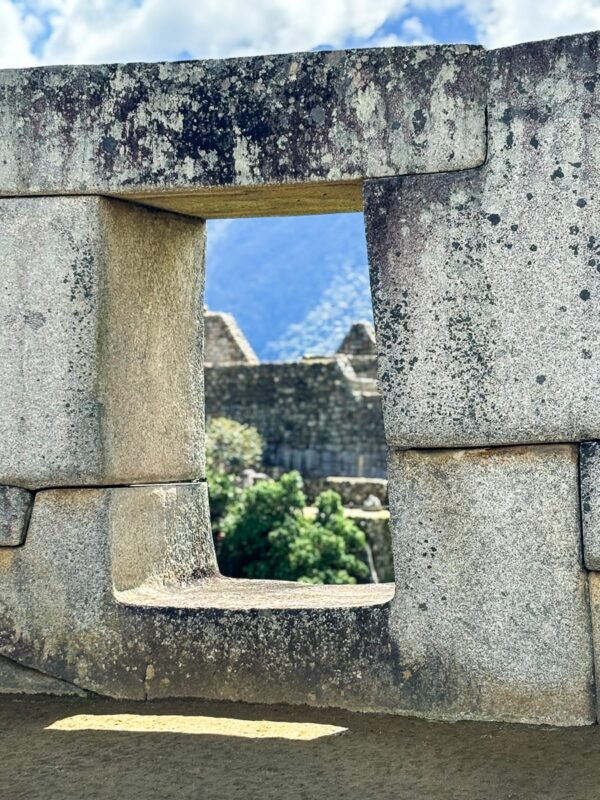
As for timing your visit within the day, there’s no definitive answer. Machu Picchu receives visitors throughout daylight hours, and the site’s popularity ensures a steady stream of tourists. Morning arrivals may contend with fog, a common occurrence during the rainy season. While some may find the mist adds an enchanting aura to the ruins, others may prefer clearer views. Afternoons typically witness a slight thinning of crowds as day-trippers begin their return journey to Cusco, offering a more serene ambiance for late-day explorations.
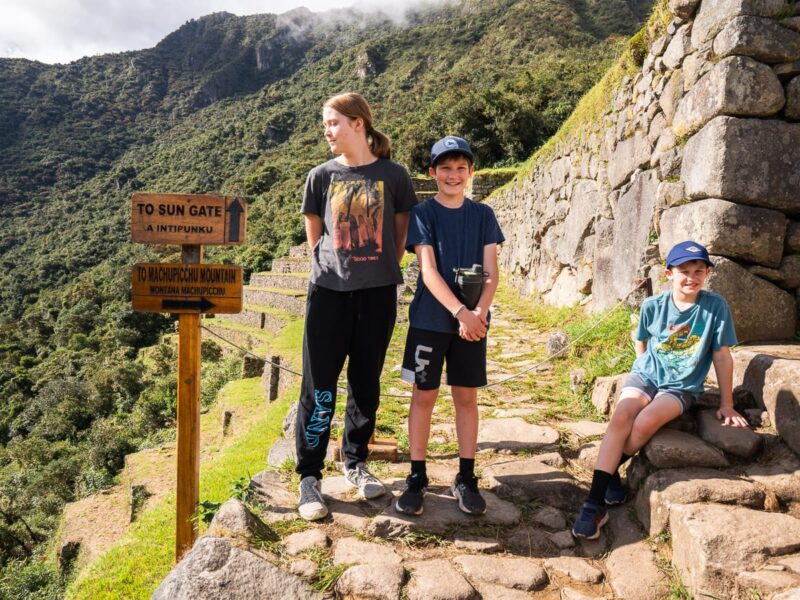
Ultimately, the best time to visit Machu Picchu depends on your preferences and priorities. Whether you seek solitude among ancient ruins or revel in the vibrant energy of fellow adventurers, Machu Picchu promises an unforgettable experience regardless of the season or time of day.
We visited in early-mid April and had a week of fantastic weather. The hillsides were lush and added to the already impressive landscape.
Purchasing Machu Picchu Tickets
If you opt to visit Machu Picchu on your own or are required to purchase your tickets yourself, make sure you do so in advance!
Likely 3-6 months before your trip, depending on the type of tickets you are looking to get. The Peruvian government has set up a ticketing system to help control and simplify the process.
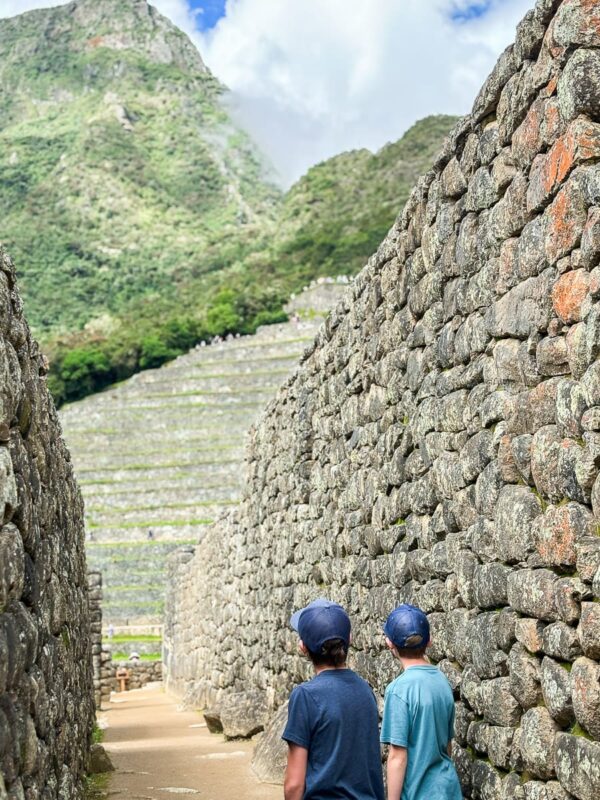
Machu Picchu offers five different “circuits” to choose from when visiting the site, and your ticket will dictate which circuit and sites within Machu Picchu you can access. However, any circuit will allow you to experience Machu Picchu fully.
So, review what each circuit allows you access to before purchasing. The circuits recently changed (mid-2024), so ensure you follow the most up-to-date information.
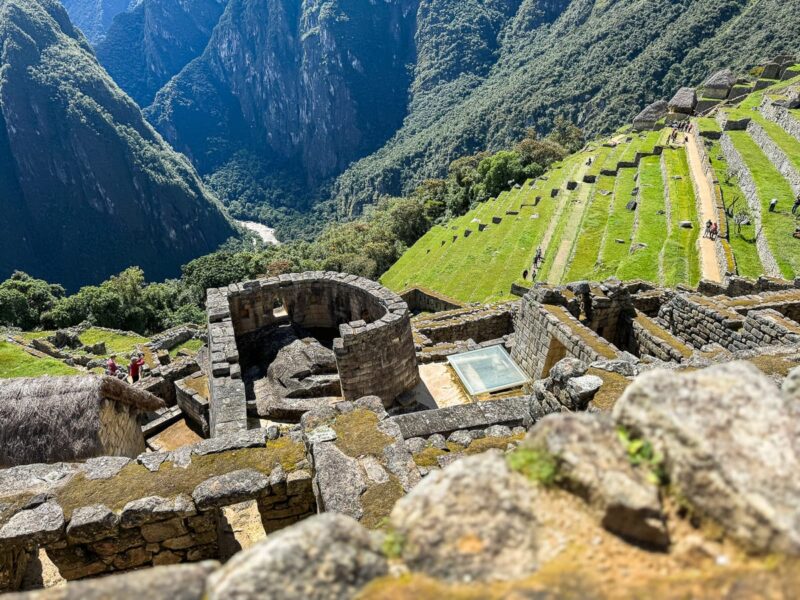
Several “side excursions” are also available for those interested, such as hiking up Huayna Picchu or Machu Picchu Mountain, but these require additional tickets.
If your tickets are included with your tour, ensure they include the circuit you prefer and any additional hikes you wish to do while there.
While one day is enough to visit Machu Picchu, some travelers opt to visit multiple days and experience different circuits or side hikes on different days.
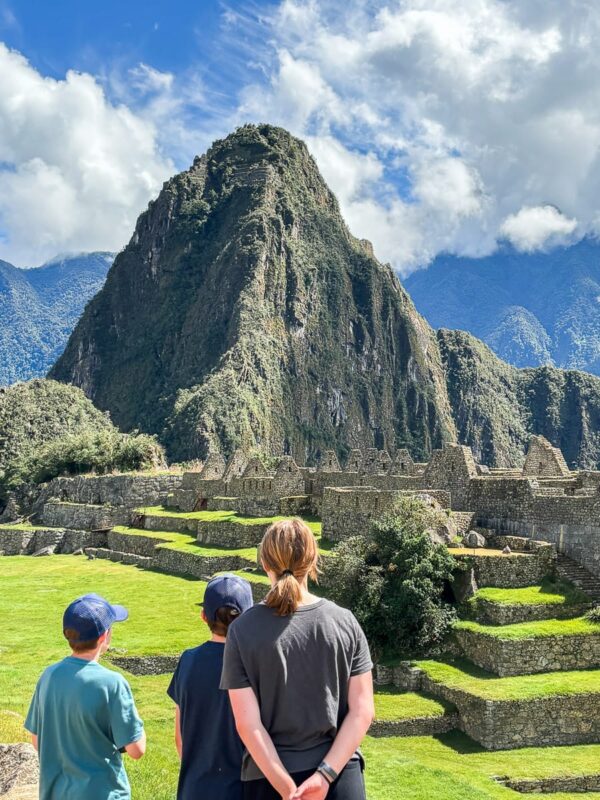
What to bring with you to Machu Picchu
Machu Picchu has some regulations on what you can and can’t bring with you, and you should confirm before your trip if these have changed or not.
We recommend that you bring:
- Water
- sunscreen
- bug spray
- Passport
- Tickets
- Soles (money)
- and layers!
You will need your passport to enter the park (but this is also required to board the bus to transport you to the entrance). We failed to apply bug spray, and our son, Sean, will be the first to tell you it was a mistake!
The mosquitoes are very small and hard to see, so we didn’t know we were bitten until it was too late.
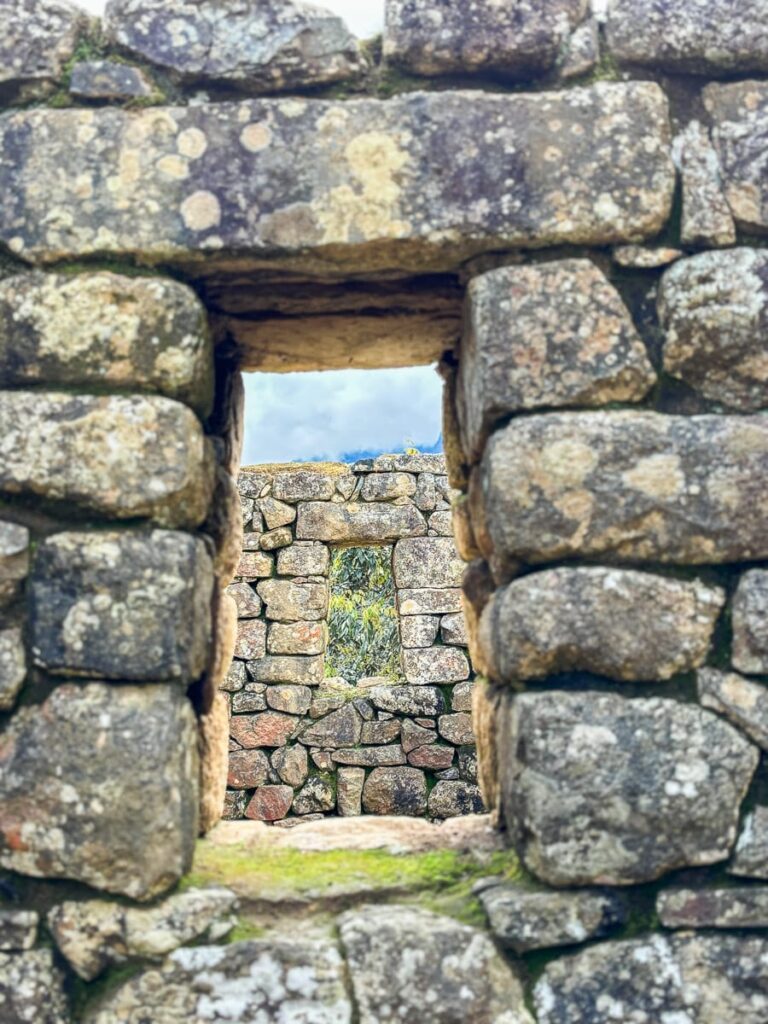
Another recommendation would be to bring some Soles for the bathroom at the entrance to Machu Picchu. It is the only restroom; when we visited, it cost $2 soles per person. There is no restroom inside Machu Picchu.
Do not bring these because they are all prohibited within Machu Picchu.:
- drones
- umbrellas
- walking sticks or trekking poles
Doing this with Kids?
Yes! There are several ways to get to Machu Picchu, and some may be easier or more suited to your family than others, so keep that in mind when determining how to get there.
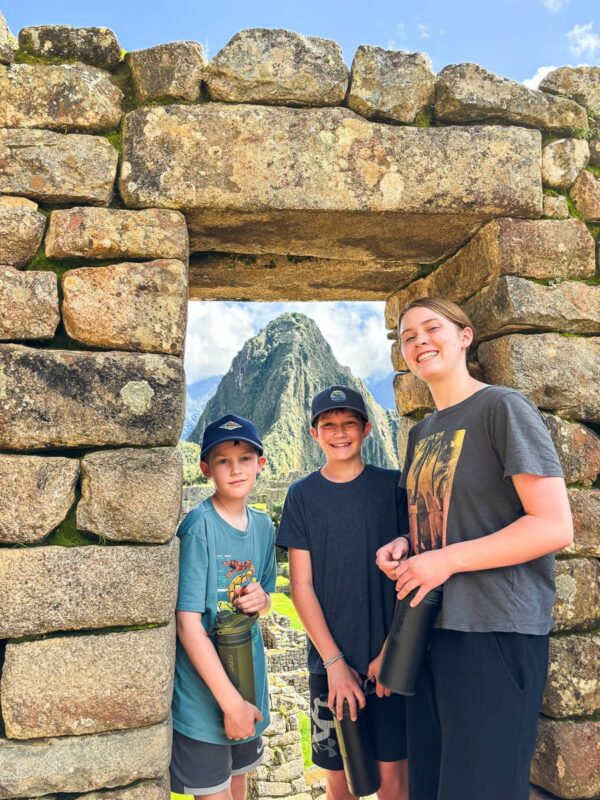
However, regardless how you plan to get to Machu Picchu, your kids can and should go along on the journey! It will be an unforgettable experience.
Taking a train to Aguas Calientes and then a bus to Machu Picchu, as we did, is by far the easiest way and can be done by almost anyone.
Children can easily wander around Machu Picchu. Just bring water, some sun protection, and bug spray. The more comfortable the kids, the easier and more enjoyable your day will be!

